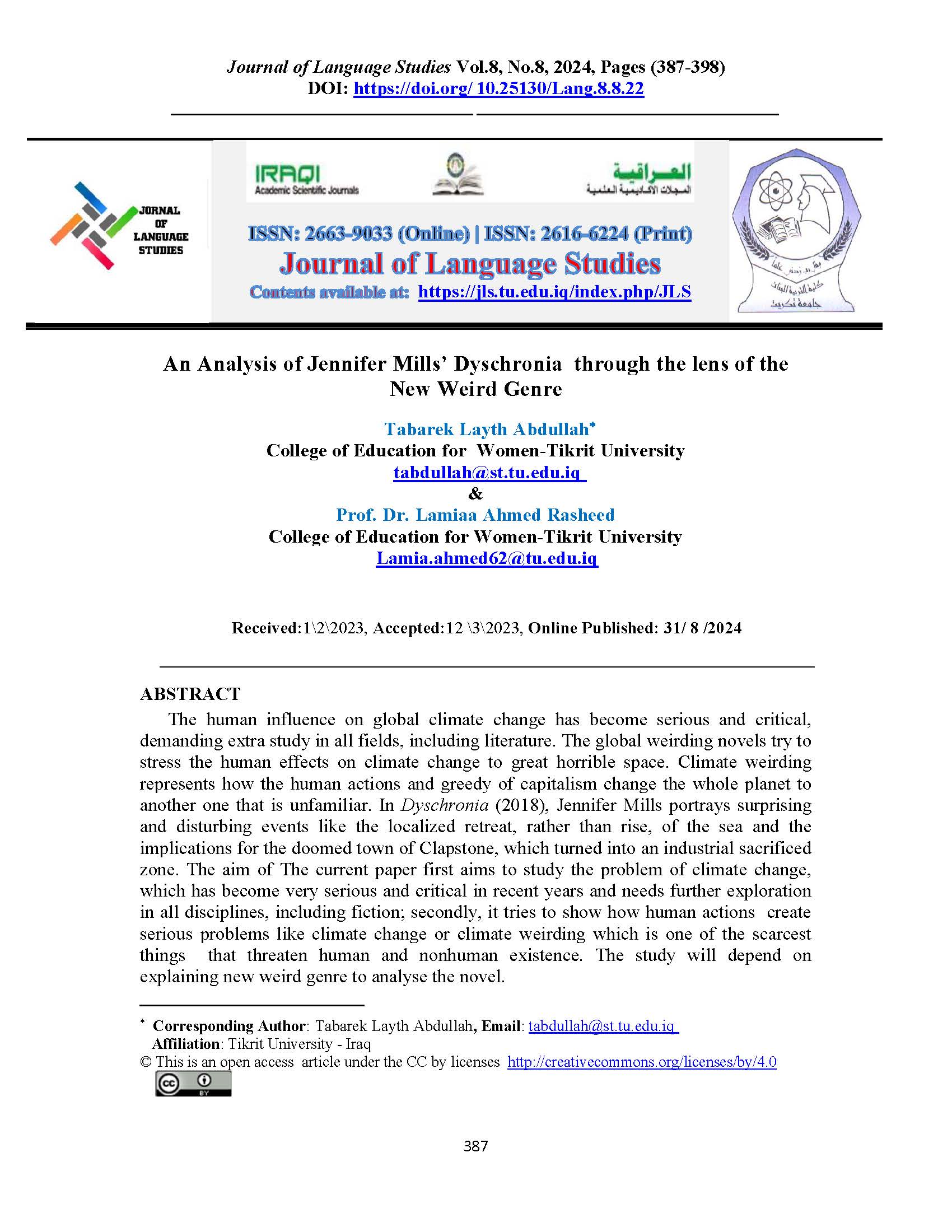An Analysis of Jennifer Mills’ Dyschronia through the lens of the New Weird Genre
Tabarek Layth Abdullah
College of Education for Women-Tikrit University
Lamiaa Ahmed Rasheed
College of Education for Women-Tikrit University
DOI: https://doi.org/10.25130/Lang.8.8.22
Keywords: new weird, climate change, Dyschronia, and anthropocene
Abstract
The human influence on global climate change has become serious and critical, demanding extra study in all fields, including literature. The global weirding novels try to stress the human effects on climate change to great horrible space. Climate weirding represents how the human actions and greedy of capitalism change the whole planet to another one that is unfamiliar. In Dyschronia (2018), Jennifer Mills portrays surprising and disturbing events like the localized retreat, rather than rise, of the sea and the implications for the doomed town of Clapstone, which turned into an industrial sacrificed zone. The aim of The current paper first aims to study the problem of climate change, which has become very serious and critical in recent years and needs further exploration in all disciplines, including fiction; secondly, it tries to show how human actions create serious problems like climate change or climate weirding which is one of the scarcest things that threaten human and nonhuman existence. The study will depend on explaining new weird genre to analyse the novel.
References
Arathimos,M. (2018, February 23). Who put the dys in dyschronia ? a book for the now generation : a review of Jennifer mills dyschronia.[Review of the book dyschronia by J.Mills]. The Lifted Brow
A sense of place. (2009, April 26). The Sydney Morning Herald. https://www.smh.com.au/entertainment/a-sense-of-place-20090426-gdthvx.html
Bonneuil, C. (2015). The geological turn: narratives of the Anthropocene. In C. Hamilton, C. Bonneuil, & F. Gemenne (Eds.), The Anthropocene and the Global Environmental Crisis: Rethinking modernity in a new epoch (pp. 17–31). Routledge.
Canavan, G., & Hageman, A. (Eds.). (2016). Introduction: “Global Weirding.” Paradoxa, 28, 7–13. https://paradoxa.com/volume-28-global-weirding/
Cardin, M.(Ed). (2017). Weird and cosmic horror fiction. In Horror Literature through History: An Encyclopedia of the Stories that Speak to Our Deepest Fears (vol.1, pp.163-168). Greenwood.
Carmody, B. (2019, June 20). How climate anxiety is changing the face of Australian fiction. The Sydney Morning Herald. https://www.smh.com.au/entertainment/books/how-climate-anxiety-is-changing-the-face-of-australian-fiction-20190619-p51z44.html
Faassen, K. (2021). Cthulhu calling: Weird intimacy and estrangement in the anthropocene. In Y. Liebermann, J. Rahn, & B. Burger (Eds.), Nonhuman Agencies in the Twenty-First Century Anglophone Novel (pp. 257–275). Palgrave Macmillan.
Fisher, M. (2016). The Weird and the Eerie. Repeater Books
Foster, J. B., Clark, B., & York, R. (2010). The Ecological Rift: Capitalism’s
War on the Earth. Monthly Review Press.
Gildfind, H.C (2018 October). Remembering the future [Review of the book Dyschronia
by J.Mills] .Text Journal,
http://www.textjournal.com.au/oct18/gildfind_rev.htm
Hassoon, A. K., & Rasheed, L. A. (2023). Social Isolation and Loneliness: A Psychoanalytic Reading of Jojo Moyes’ Me Before You. Journal of Language Studies, 4(3), 11–21. https://doi.org/10.25130/jls.4.3.2
Head, L., Adams, M., McGregor, H., & Toole, S. (2013). “Climate Change and Australia.” .WIREs Climate Change, 5(2), pp. 175–197. https://doi.org/10.1002/wcc.
Howarth, F. (2018, January 28). [Review of the book Dyschronia by J. Mills]. Readings.
https://www.readings.com.au/reviews/dyschronia-by-jennifer-mills
Kirne, J. (2019). Extinction, and unsteady temporalities in jennifer mills’ “dyschronia.” International Journal of Practice Based Humanities, 3. https://www.academia.edu/41247672/Jack_Kirne_Staggered_Time_Catastrophe_Extinction_and_Unsteady_Temporalities_in_Jennifer_Mills_Dyschronia_2018_
Longo, S. B., Clausen, R., & Clark, B. (2015). The Tragedy of the Commodity: Oceans, Fisheries, and Aquaculture. Rutgers University Press.
MasterClass. (2022, January 20). “Notable Weird Fiction Author”. https://www.masterclass.com/articles/weird-fiction
Miéville, C. (2009). “Weird fiction”. In M. Bould, A. Butler, A. Roberts, & S. Vint (Eds.), The Routledge Companion to Science Fiction (pp. 510–515). Routledge.
Mills, J. (2018). Dyschronia. Macmillan Publishers.
Philander, S. G (Ed). (2012) Australia. In Encyclopedia of Global Warming and Climate Change (2nd Edition,pp.101-104). SAGE Publications
Rasheed, L. A., & Abdullah, T. L. (2023). Climate Change in Jennifer Mills Dyschronia: An Eco-Social Critical Study. Journal of Namibian Studies : History Politics Culture, 33. https://doi.org/10.59670/jns.v33i.518
Sederholm, C. H. (2019). The new weird. In M. Wester & X. A. Reyes (Eds.), Twenty-First-Century Gothic (pp. 161–173). Edinburgh University Press.
Tabas, B. (2015). Dark places: Ecology, place, and the metaphysics of horror fiction. Miranda, 11, 1-21. https://doi.org/10.4000/miranda.7012
Trexler, A. (2015). Anthropocene Fictions: The Novel in a Time of Climate
Change. University of Virginia Press.
Ulstein, G. (2019). ‘Age of Lovecraft’?—Anthropocene Monsters in (New) Weird Narrative. Nordlit,42 ,47-66. https://doi.org/10.7557/13.5004
Ulstein, G. (2021). Heights they should never have scaled: Our (Weird) planet. SubStance, 50(3), 14–33. https://doi.org/10.1353/sub.2021.0020
VanderMeer, A., & VanderMeer, J. (2008). The New Weird. Tachyon Publications.
Vermeulen, P. (2020). Literature and the Anthropocene. Routledge.

